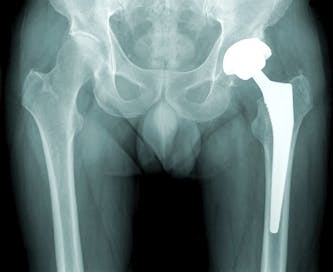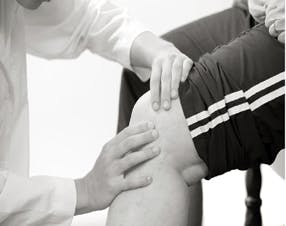Return to ithe Lifestyle you love

With our: Joint Replacement Care Program
Physical Rehabilitation following an orthopedic surgery is a very challenging and demanding experience. Our rehabilitation program for joint replacement surgery was established to assist our patients in setting and achieving their goals to maximize functional recovery and independence.
If you suffer from the symptoms listed below, joint replacement surgery could be a viable option for you.
- Pain limiting everyday activities such as walking and bending.
- Pain continues while resting, either day or night.
- Stiffness in a joint limits your ability to move.
- You get little pain relief from anti-inflammatory drugs.
- You have harmful or unpleasant side effects from medications.
- Other treatments, such as physical therapy don't relieve pain.
What is Total Joint Replacement?

Total joint replacement relieves pain by replacing an arthritic or damaged joint with an artificial one called a prosthesis. The prosthesis is generally composed of a metal piece that fits closely into a matching sturdy plastic piece. A plastic bone cement may be used to anchor the prosthesis into the bone. It may also be implanted without cement when the prosthesis and the bone are designed to fit and lock together directly, with the bone growing into the prosthesis.
When is a Total Joint Replacement Recommended?
A joint is formed by the ends of two or more bones, which are connected by thick tissues. The bone ends are covered with a smooth layer called cartilage. Normal cartilage allows nearly frictionless and pain-free joint movement. The process whereby cartilage becomes damaged or diseased is known as arthritis. The affected joint resultantly becomes stiff, swollen and painful. Joint pain may also be caused by trauma, such as a serious fracture or an injury that doesn't heal properly. The pain may be so severe a person will avoid using the joint, weakening the muscles around it and making movement even more difficult. When other treatment options such as medication, physical therapy and lifestyle adjustments do not relieve joint pain and disability, total joint replacement may be considered. Joint replacement surgery can provide remarkable relief of pain from arthritic joints. In doing so, many patients are able to return to fully active lives. Surgical techniques and implants have improved dramatically in recent years providing for faster recovery and functional return.
Total joint replacements can be performed on any joints of the body, including the hip, knee, ankle, foot, shoulder, elbow, wrist, and fingers with the most common procedures currently being: (click the headings below for more information)
Total Hip Replacement
A total hip replacement is indicated for people who have pain from arthritis that has not been adequately controlled by medications or activity modifications. Although near complete relief of pain and improved function can be achieved, these are man-made devices and as such will wear out in time. Thus, younger, very active patients must be aware that future surgery may be necessary and that certain higher impact type activities should be avoided. This generally applies for all joint replacements. Common conditions treated with hip replacement are osteoarthritis, rheumatoid arthritis, arthritis from a previous injury or fracture, arthritis from hip dysplasia and avascular necrosis of the hip. Hip implants are of two basic designs: those fixed to bone by cement and those fixed to bone via bone ingrowth into the prosthesis itself. Both can achieve excellent results. In general, younger, more active patients will receive bone ingrowth type implants. This form of fixation is living and more dynamic, but does rely on healthy bone to actively attach the prosthesis. Older patients with thinner bone will do better with cement fixation. Generally, the cup side of the hip replacement is fixed without cement in both age groups.
Total Knee Replacement
Patients who have disabling pain in the knee, as a result of arthritic involvement are, as a rule, candidates for replacement of the knee joint. Many measures are generally tried before deciding to perform the knee replacement. The use of physical therapy, exercises, anti-inflammatory medication and injections into the knee may be tried prior to surgery. In the patient who has advanced arthritic changes in the knee, function becomes impaired. Pain will be felt when walking and many times while at rest. Deformity of the knee and painful swelling of the joint also frequently occur, and the patient may notice that the knee is becoming bowed or knock-kneed. Stiffness of the knee often develops in patients with arthritic knees as well as swelling. In essence, the surfaces of the femur (thigh bone), tibia (leg bone), and patella (kneecap) in the knee are “resurfaced” with metal and plastic. These components are fit precisely to the ends of these bones, and often cemented into place. The prosthesis will then be moved by the muscles and ligaments that normally move the knee. It will be lubricated by the same synovial fluid that lubricates the normal joint. The materials used in these prostheses have over a thirty year track record for implantation in humans.
Total Shoulder Replacement
Shoulder replacement can be done for people who have a variety of shoulder problems. Most commonly, it is done for those who suffer from severe arthritis, a condition where the cartilage in your shoulder joint has worn away. However, it can also be done for those who have destruction of the joint from other causes, or pain and dysfunction from a rotator cuff tear which cannot be repaired. While most patients seeking a shoulder replacement are over fifty years old, shoulders in any skeletally mature adult can be candidates. Shoulder replacement surgery replaces damaged surfaces with prostheses. Typically, prostheses have two components: the humeral (upper arm bone) component, which is made of metal and the glenoid (socket) component, which is made of polyethylene. Most shoulder replacements are secured with bone cement or screw fixation. Determining the type of shoulder replacement a patient needs depends on whether both sides of the joint are arthritic and whether there are adequate muscles to control the arm after surgery. If both sides of the joint are affected, replacing both sides gives the best pain relief and function.
What happens before surgery?

Once it is determined by your orthopedic surgeon that you are a candidate for a joint replacement your physician may refer you to physical therapy for a pre-operative consult.
During this consult your physical therapist will discuss and teach you:
- What to expect with the surgical procedure.
- Pre and Post Operative management and precautions of the procedure ensuring the maximal outcome from the procedure is attained.
- What will happen before and after surgery?
- Pre - post operative exercises.
What Happens After Surgery?
Typically, a short hospital stay is required where you will work with inpatient rehabilitation therapists to begin the therapy process.
Following discharge from the hospital, your physician may recommend home physical therapy until you are able to adequately and safely leave the home and attend outpatient physical therapy.
Or:
Your orthopaedic surgeon will send you or you can ask to go to Professional Rehabilitation Services, Outpatient Joint Replacement Care Program after home therapy or hospital discharge to begin working with our Board Certified Orthopaedic Physical Therapists.
What Happens At Physical Therapy?

Physical Therapy will play an important role in recovering from a joint replacement. While attending therapy your therapist will be working hands on with you at every session to regain range of motion (ROM) and strength while using modalities and manual techniques to control pain and swelling. Depending on the type of joint replacement you have had as your ROM and strength progresses your therapist will be gradually returning you to your previous functional activities and independence.
For lower extremity replacements including total hip and knee replacements this will include transfer training, gait training, and gradually progressing you off of any assistive device you may of needed following surgery, returning you to normal walking activities which include going up and down stairs.
For upper extremity replacements, the most common being the total shoulder, this would include gradually returning to overhead reaching activities as strength and motion permits.
Therapists design specific exercise programs that patients can perform independently to accelerate the recovery process. Also pain-relieving modalities such as ice, heat, ultrasound and electrical stimulation may be used.

The muscle groups supporting the replaced joint are treated to achieve optimal strength and balance to the joint and limb, as well as restoring optimum joint motion.
Physical therapy Goals for joint replacements:
Click on the headings below for more information.
Total Hip Replacement Therapy goals
Hip replacement surgery has a delicate and lengthy recovery time, so it is vital that a patient strictly adhere to the recommendations set forth by the surgeon. Two to four days after a successful hip replacement surgery, a patient is usually discharged from the hospital. To care for your new hip and keep it from sliding out of position, you will need to follow a few general restrictions at first. Your surgeon may recommend some additional restrictions based on your condition and type of surgery before the rehabilitation process begins such as.
- DO NOT bend your hip more than 90 degrees
- DO NOT cross your legs
- DO NOT turn your operated leg inward (pigeon-toed)
Physical therapy is a very important part of your surgery and will help in restoring strength in the replaced hip. With physical therapy we will work on allowing a 90-degree (flexion) of the hip with rehabilitative exercises. You will need to be able to bend 90 degrees to be able to do things like get in and out of a car easily. You will also need to get your leg to move out to the side and backwards. It is up to you to make your hip work properly. You must work hard to achieve optimal range of motion and strength in your hip to receive the full benefit of your new joint. Your commitment to your exercise program is the key to your full recovery. For the maximum function of your hip you must stretch and strengthen the muscles around your hip. The stronger your muscles are, the more they can support the use and movement of your new hip.
Total Knee Replacement Program Goals
A patient is usually discharged from the hospital one to three days after a successful knee replacement surgery. The goals of the Total Knee Replacement Program is to return a patient knee(s) to normal knee function, which will be achieved by:
- Allowing a complete extension of the leg (0-degree extension)
- Allowing a perpendicular bend of the leg (90-degree bend)
- Advancing to a 120-degree bend to regain full ability again

You should be able to bend your new knee to at least 90 degrees, (flexion). 90 degrees will be your minimum goal, but we will try to get your knee to bend to 120 degrees (our maximal goal and your best outcome). You will need to be able to bend at least to 90 degrees to be able to do things like get in and out of a car easily.
You will also need to get your leg straight from knee to toe (0 degree extension). Getting your knee straight is just as important as getting it to bend. If you do not have full extension, you won't be able to get your heel down all the way when you walk.
Physical therapy is a very important part of your surgery. It is up to you to make your knee work properly. You must work hard to achieve full flexion and extension in your knee to receive the full benefit of your new joint. Your commitment to your exercise program is the key to your full recovery. For the maximum function of your knee, you must stretch and strengthen the muscles around your knee. The stronger your muscles are, the more they can support the use and movement of your new knee.
Total Shoulder Replacement Program Goals
After a successful shoulder replacement surgery, two to four days of hospital recovery time is normal before a patient is discharged. The Total Shoulder Replacement Program will allow the patient to take full advantage of their new joint by:
- Providing physical therapy to strengthen the shoulder
- Administering superior quality health care services to reduce scarring
- Using rehabilitative exercises to improve range of motion
Rehabilitation exercise should help strengthen your shoulder, improve range of motion and reduce scarring so that you can get back to your normal activities sooner. Physical therapy is a very important part of your surgery. While patients whose jobs do not involve overhead lifting may resume work and moderate exercise within a relatively short time, depending on the procedure, quite frequently patients do require months of rehabilitation. It is up to you to make your shoulder work properly. You must work hard to achieve full motion in your shoulder to receive the full benefit of your new joint. Your commitment to your exercise program is the key to your full recovery. For the maximum function of your shoulder, you must stretch and strengthen the muscles around your shoulder. The stronger your muscles are, the more they can support the use and movement of your shoulder.
Professional Rehabilitation Services Rehabilitation Team is committed to assisting you in reaching your maximum functional level. They will keep you informed of your progress and continue to communicate with your physician so he or she is also aware of your progress.
How long will the therapy process take?
In preparing for the duration of time you should set aside prior to returning to your previous activities following joint replacements, the general trend for outpatient therapy following lower extremity total joint replacements is roughly six to eight weeks, for upper extremity replacements in particular the shoulder the duration tends to be a little longer simply because the shoulder is a much more complex joint and has more planes of movement to rehab. You should allow twelve to sixteen weeks of outpatient physical therapy following total shoulder replacement
About Us
The Joint Replacement Care Program at Professional Rehabilitation Services provides specialized therapy services for treating conditions of the knee, hip, shoulder, elbow, foot, and ankle.
Our team of Physical Therapists are Board Certified Orthopedic Specialists. We work with your surgeon to help you heal, return to function and to live a full active life. Your therapist will send progress notes to your physician indicating your functional level and progression. Jointly, they will decide based upon your overall progress and functional return when your rehab is completed.
Free Consultation

Call for a Free 15 Minute Consultation with a Physical Therapist to learn more about our Joint Replacement Care Program!
Download our Referral
Download our Physician Referral and let your physician know we are your choice for your Joint Replacement Care.
